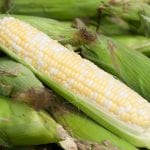 Maryland’s sweet corn is one of our classic summer veggies, eagerly awaited from the first day the air warms in spring. Unlike tomatoes, peaches and watermelon, which keep you waiting and waiting in anticipation, sweet corn comes in early and, thanks to farmers who wisely stagger planting times to spread out the harvest, stays with us all summer.
Maryland’s sweet corn is one of our classic summer veggies, eagerly awaited from the first day the air warms in spring. Unlike tomatoes, peaches and watermelon, which keep you waiting and waiting in anticipation, sweet corn comes in early and, thanks to farmers who wisely stagger planting times to spread out the harvest, stays with us all summer.
How do you choose the best ear of sweet corn? We’ve got a few tips:
At the market or store, pick up the ear. It should feel heavy for its size – a sign that the kernels inside are still full of moisture and fresh. The outer leaves – known as husks – should be bright green, tightly wrapped around the ear and feel flexible and a little damp under your touch. Dry, faded and papery husks, and lightweight ears, are signs that the corn is old and dry. When it comes to sweet corn, the fresher, the better.
Corn silk, which is the hairy part from the top of the ear, is an important indicator of both freshness and maturity. The silk extending from the husk should be soft and light brown to golden-colored. Inside the husk (it’s okay to pull back the husk to look), the silk should still be damp, flexible and light yellow.
Each strand of silk attaches to a kernel. Kernels should be plump, tightly packed together, and fully formed across the length of the ear except at the tip. Run your hand along the ear with gentle pressure to feel if the whole ear has filled out with kernels. If it isn’t, that just means something – possibly a dry spell – interrupted pollination. There’s nothing wrong with eating the ear, you just won’t get as many satisfying kernels.
Now, back to the tip. Ears that have large, fully formed kernels all the way to the tip of the ear, sometimes giving it a rounder shape, are more mature than ears that have progressively smaller and smaller kernels all the way to a somewhat pointy tip.
While the more mature ear may be too tough for your liking if you’re simply eating the corn on the cob, consider how the slightly tougher kernels would hold up better for you if you’re going to grill the ears or cut them off to make a corn salad. Choose ears that will work best for your recipe.
After choosing your ears, keep them cool on the way home. Heat promotes spoilage, in which the sugary contents begin to turn sour. Ideally, buy and cook corn that was picked that same day. If you’re going to eat it right off the cob, we recommend boiling: Bring a large pot of water to a full rolling boil, drop in the corn, and cook for one to three minutes. Boiling this way cooks the kernels lightly – which is all they need – and allows the cob to stay cooler, reducing burned fingers.
All of these tips are valid for any variety of sweet corn you choose, from white to yellow or even bicolor. Today’s sweet corn varieties come in three flavor profiles: sugary, super sweet, and sugary enhanced. If you get the chance, ask what variety you’re buying and run a side-by-side taste test – twice if you need to – Maryland farmers will grow more!
Find local farms with markets at the Maryland’s Best website. It’s the perfect place to find everything you need for the Buy Local Challenge, which happens every year in late July. But with fresh, local produce available year-round from Maryland farmers, why wait?
Hungry for more? Sign up for our newsletter and find us on Facebook, Twitter and Instagram.

